Walking through Spectral Evidence, Nancy Bowen’s installation at the Provincetown Art Association and Museum, is humorously odd and gravely unsettling in equal measure. Twenty squat grave markers with wings and skull heads stand before a life-size ghostly figure. Faceless and wearing a black hair shirt, he is suspended over a podium made of stairs and tiny gallows. The whole scene is framed by the gabled roof of the spacious Hans Hofmann Gallery.
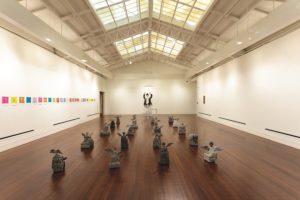
The figure is Samuel Sewall, one of the nine judges responsible for condemning 20 souls to death in the Salem witch trials of 1692-1693. Sewall is Bowen’s 14th-generation great uncle on her mother’s side, says the artist, who maintains a studio in New York and is a sculpture professor at SUNY Purchase.
Raised near Narragansett Bay in Rhode Island, Bowen always knew of her infamous uncle. “I grew up embarrassed that I had this ‘witch killer’ for an ancestor,” she says. But it was only in the last five years that she discovered the depth of his involvement and his eventual public apology.
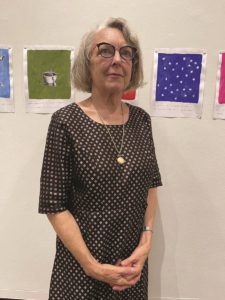
Sewall kept a diary for most of his life. “Much of what we know about Massachusetts in the 1600s is from his diary,” says Bowen. “He wrote down everything — what they were eating, where he was going. His wife died when he was in his 60s, and he courts new women and writes all about that. He has two more wives! It’s a pretty hilarious document.”
The diary also humanizes him. “He wrote poetry,” says Bowen. “But for me, what was most interesting was that during the trials he used this phrase ‘spectral evidence.’ Some of the testimony was absurd: ‘I had a dream that you turned a cow into a pig! You’ve got to be a witch!’ Sewall was bothered by the idea they were using that as evidence. He didn’t think it was sufficient.”
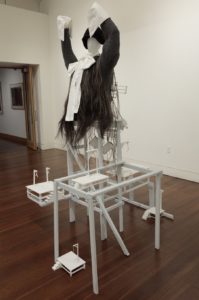
But the judges were driven by piety, hysteria, and the influence of Chief Magistrate William Stoughton. Four years after the trials ended, Sewall asked the minister of his church to read his confession. He admitted that he had sinned, and that those accused of witchcraft should not have been killed. From then on, he wore a hair shirt under his clothes as penance. A few years later, he wrote The Selling of Joseph, one of the first antislavery tracts published in what would become the United States.
Bowen thinks of her installation as carrying Sewall’s work forward. “I was reading about this when Trump was in power,” she says, “and thought, ‘If a man could get up and say he made a mistake, wouldn’t that be incredible!’ ”
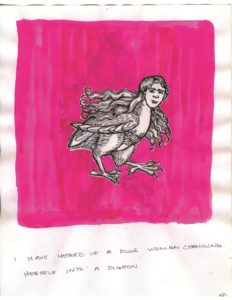
Though it evokes events of more than 300 years ago, Spectral Evidence is timely and potent. The installation is a reminder of the constant vigilance required to secure and maintain human rights.
Accompanying the installation are 46 works on paper, each illustrating a stanza of the poem The Witch by Elizabeth Willis, a descendant of one of the women executed as a witch in Salem. Bowen was introduced to Willis by a mutual friend. The collaboration is a form of intergenerational psychic reconciliation between Judge Sewall and the 20 victims.
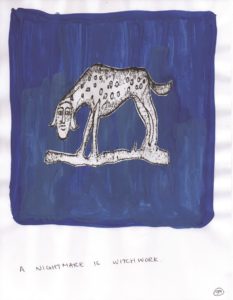
“I think a lot of the show is about repentance, about making amends,” says Bowen.
The works on paper — which combine gouache with digital and collage elements — push the narrative forward with humor. This lightheartedness is also expressed in the 20 gravestones that stand before the judge. From the back, they look like a rookery of malevolent penguins. “I gave them feet because I wanted them to be present and walking, but I also gave them wings,” says Bowen. “I was thinking about ascension, and the faces and wings come from early American gravestones.” The names of the victims are on the bottoms of the figures.
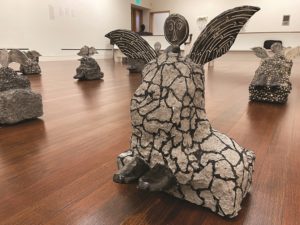
Collectively, they counteract the darkness without diluting the content, allowing viewers a way in. “I’m not making fun of it,” says Bowen. “Humor sometimes makes hard things accessible.”
The witch trials are still relevant today, with mass hysteria spawning violent events such as the storming of the Capitol on Jan. 6. The subtext is fear, propagated by false rumor.
“Nobody really understands the witch trials,” says Bowen. “Why there? Why then?” The irony, she adds, is that the accusers became the evil they believed they were purging.
Ghost in the Museum
The event: Spectral Evidence, an installation by Nancy Bowen
The time: Wednesday through Monday, 11 a.m. to 5 p.m.; through Nov. 14
The place: Provincetown Art Association and Museum, 494 Commercial St.
The cost: Adults $12.50; under 16, free
